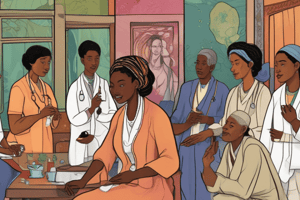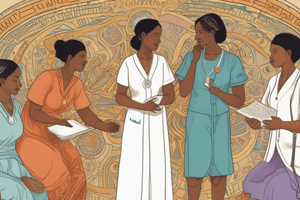Podcast
Questions and Answers
What is the process by which individuals adopt the cultural traits of another group called?
What is the process by which individuals adopt the cultural traits of another group called?
- Ethnocentrism
- Acculturation (correct)
- Assimilation
- Cultural competence
Which term describes the ability to effectively interact with people across different cultures?
Which term describes the ability to effectively interact with people across different cultures?
- Cultural competence (correct)
- Cultural awareness
- Cultural literacy
- Cross-cultural communication
What defines a cultural-bound syndrome?
What defines a cultural-bound syndrome?
- Symptoms recognized only within a specific culture (correct)
- Symptom patterns widely accepted by medical professionals
- Universal psychiatric symptoms
- Recognizable diseases across cultures
What do health disparities refer to?
What do health disparities refer to?
Which of the following accurately describes health literacy?
Which of the following accurately describes health literacy?
What is ethnocentrism?
What is ethnocentrism?
Which of the following factors is NOT considered a determinant of health?
Which of the following factors is NOT considered a determinant of health?
Which definition best describes culture?
Which definition best describes culture?
What is a significant consequence of health disparities in society?
What is a significant consequence of health disparities in society?
Why are culturally competent skills essential for healthcare providers?
Why are culturally competent skills essential for healthcare providers?
Which component is NOT part of a cultural assessment?
Which component is NOT part of a cultural assessment?
How can healthcare providers effectively implement a cultural assessment?
How can healthcare providers effectively implement a cultural assessment?
What characterizes individualistic cultures in terms of decision-making?
What characterizes individualistic cultures in terms of decision-making?
Which term describes discrimination based on age?
Which term describes discrimination based on age?
What is a key characteristic of collectivist cultures?
What is a key characteristic of collectivist cultures?
Elder mistreatment refers to which of the following?
Elder mistreatment refers to which of the following?
What characterizes a frail older adult?
What characterizes a frail older adult?
Which statement is true regarding Medicaid?
Which statement is true regarding Medicaid?
What is the primary difference between delirium and dementia?
What is the primary difference between delirium and dementia?
Which of the following is not a common age-related physiological change?
Which of the following is not a common age-related physiological change?
What care priority involves regular monitoring and treatment of existing medical conditions?
What care priority involves regular monitoring and treatment of existing medical conditions?
Which of the following best describes polypharmacy?
Which of the following best describes polypharmacy?
What is one of the main roles of local senior centers?
What is one of the main roles of local senior centers?
What is the primary focus of chiropractic medicine?
What is the primary focus of chiropractic medicine?
What condition is characterized by chronic cognitive decline?
What condition is characterized by chronic cognitive decline?
Which of the following best describes integrative medicine?
Which of the following best describes integrative medicine?
Which classification of CAM includes acupuncture and yoga?
Which classification of CAM includes acupuncture and yoga?
What is a significant safety concern related to the use of CAM?
What is a significant safety concern related to the use of CAM?
Which of the following is NOT considered a type of complementary and alternative medicine?
Which of the following is NOT considered a type of complementary and alternative medicine?
Which approach to healthcare takes into account the whole person?
Which approach to healthcare takes into account the whole person?
What is a common goal of complementary and alternative medicine practices?
What is a common goal of complementary and alternative medicine practices?
Which of the following is included in the classification of natural products in CAM?
Which of the following is included in the classification of natural products in CAM?
Flashcards
Health Disparities
Health Disparities
Unequal access to healthcare leading to worse health outcomes, especially in disadvantaged groups.
Culturally Competent Skills
Culturally Competent Skills
Skills that help healthcare providers communicate effectively with diverse patients to improve trust and outcomes.
Cultural Identity
Cultural Identity
Understanding a patient's cultural background and its influence on their health.
Cultural Explanations of Illness
Cultural Explanations of Illness
Signup and view all the flashcards
Individualism
Individualism
Signup and view all the flashcards
Collectivism
Collectivism
Signup and view all the flashcards
Ageism
Ageism
Signup and view all the flashcards
Chronic Illness
Chronic Illness
Signup and view all the flashcards
Acculturation
Acculturation
Signup and view all the flashcards
Culture
Culture
Signup and view all the flashcards
Cultural competence
Cultural competence
Signup and view all the flashcards
Cultural-bound syndrome
Cultural-bound syndrome
Signup and view all the flashcards
Determinants of health
Determinants of health
Signup and view all the flashcards
Ethnicity
Ethnicity
Signup and view all the flashcards
Health disparities/equity
Health disparities/equity
Signup and view all the flashcards
Health literacy
Health literacy
Signup and view all the flashcards
Acupuncture
Acupuncture
Signup and view all the flashcards
Chiropractic medicine
Chiropractic medicine
Signup and view all the flashcards
Complementary and alternative medicine (CAM)
Complementary and alternative medicine (CAM)
Signup and view all the flashcards
Conventional medicine
Conventional medicine
Signup and view all the flashcards
Holistic care
Holistic care
Signup and view all the flashcards
Integrative medicine
Integrative medicine
Signup and view all the flashcards
Natural products
Natural products
Signup and view all the flashcards
Safety concerns of CAM
Safety concerns of CAM
Signup and view all the flashcards
Frail older adult
Frail older adult
Signup and view all the flashcards
Medicaid
Medicaid
Signup and view all the flashcards
Medicare
Medicare
Signup and view all the flashcards
Delirium
Delirium
Signup and view all the flashcards
Dementia
Dementia
Signup and view all the flashcards
Polypharmacy
Polypharmacy
Signup and view all the flashcards
Preventive care
Preventive care
Signup and view all the flashcards
Fall prevention
Fall prevention
Signup and view all the flashcards
Study Notes
Cultural Considerations
- Acculturation: Individuals adopt cultural traits of another group.
- Culture: Customs, arts, social institutions, and achievements of a particular group.
- Cultural competence: Ability to understand, communicate and interact effectively across cultures.
- Cultural-bound syndrome: Combination of psychiatric and somatic symptoms recognized only within a specific culture.
- Determinants of health: Factors impacting health (environment, genetics, income, education, relationships).
- Ethnicity: Quality of belonging to a population group sharing common descent or culture.
- Ethnocentrism: Evaluating other cultures based on one's own culture's standards.
- Health disparities: Differences in disease burden, injury, violence or opportunity to achieve optimal health in disadvantaged populations.
- Health equity: Fair and just opportunity for all to achieve optimal health.
- Health literacy: Ability to find, understand and use health information and services.
- Health status: Individual perception of health (excellent, very good, good, fair, poor).
- Race: Category of people sharing physical traits.
- Sexuality: Capacity for sexual feelings and expression of sexual behavior.
- Stereotyping: Oversimplified and fixed ideas about a person or group.
Impact of Health Disparities
- Negative impact on health and welfare of society.
- Creates unequal access to healthcare.
Importance of Culturally Competent Skills
- Crucial for effectively communicating and treating patients from diverse backgrounds.
- Improves patient satisfaction and better health outcomes
- Builds trust.
Components of a Cultural Assessment
- Cultural identity: Understanding the patient's background.
- Cultural explanations of illness: How the patient perceives their illness.
- Cultural factors related to psychosocial environment: Family dynamics and social support.
- Cultural elements of the relationship: Communication styles and decision-making preferences.
- Impact on nursing: Personalizing care plans based on cultural beliefs and practices.
Implementing Elements of a Cultural Assessment
- Conducting interviews: Asking open-ended questions about cultural background.
- Observing interactions: Noting non-verbal cues and communication styles.
- Collaborating with cultural mediators: Working with interpreters or cultural liaisons.
Individualism vs. Collectivism
- Individualism: Cultures valuing individual autonomy and personal achievements.
- Collectivism: Cultures emphasizing group harmony and collective well-being.
- Impact on decision-making: Individualistic vs collectivistic approach to decision making.
Geriatric Implications for Medical-Surgical Nursing
- Ageism: Discrimination based on age.
- Chronic Illness: Long-term conditions that may not have a cure.
- Elder mistreatment: Abuse or neglect of older adults.
- Ethnogeriatric: Study of how ethnicity and culture affect older adults' health and well-being.
- Frail older adult: Older adults with multiple health issues and decreased physical function
- Medicaid, Medicare: Government programs supporting medical costs for older adults and other groups with limited incomes.
- Delirium: Acute decline in cognitive function often reversible.
- Dementia: Chronic progressive cognitive decline
- Living will/Advance directives: Legal documents outlining medical treatment wishes.
Demographics of the Aging Population
- Rapidly growing population due to increased life expectancy and declining birth rates.
Age-Related Physiological Changes
- Cardiovascular: Decreased cardiac output, increased blood pressure.
- Respiratory: Reduced lung capacity, decreased oxygenation.
- Musculoskeletal: Loss of bone density, decreased muscle mass.
- Neurological: Slower cognitive processing, increased risk of neurodegenerative diseases.
- Sensory: Decline in vision, hearing, taste, and smell.
Common Health-Care Issues of the Elderly
- Chronic diseases (hypertension, diabetes, arthritis).
- Mental health issues (depression, anxiety, dementia).
- Mobility issues (falls, fractures).
- Polypharmacy (multiple medications increasing adverse drug interactions).
Care Priorities for the Geriatric Population
- Preventive care: Vaccinations, screenings.
- Chronic disease management: Regular monitoring and treatment.
- Mental health support: Counseling and social activities.
- Fall prevention: Home safety assessments and physical therapy.
Resources for the Elderly
- Local senior centers: Social activities and support services.
- Home health care: Medical and personal care at home.
- Community health clinics: Affordable healthcare services.
- Support groups: Emotional and social support
Complementary and Alternative Care Initiatives
-
Key Terms: Acupuncture, Chiropractic medicine, Complementary and alternative medicine (CAM), Conventional medicine, Holistic care, Integrative medicine, Western medicine.
-
Classifications of CAM: Natural products, Mind-body practices, Manipulative and body-based practices, Energy therapies.
-
Nursing implications and safety concerns: Knowledge of CAM practices, accurate information to patients, Potential interactions with conventional treatments, Lack of regulation and standardization, need for evidence-based practice.
Studying That Suits You
Use AI to generate personalized quizzes and flashcards to suit your learning preferences.




